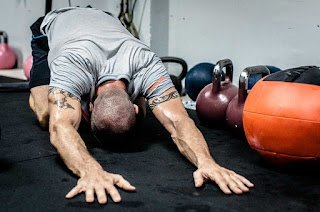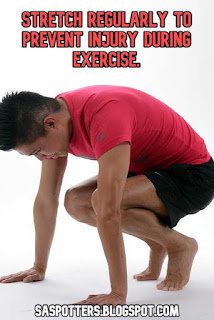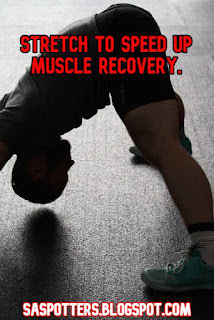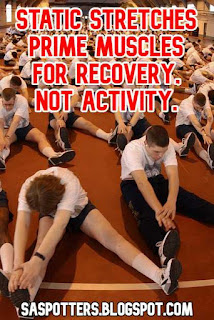 |
| Stretching can increase muscle growth. |
You should stretch to increase muscle size
When you think about building muscle, stretching is probably not at the top of your priority list.
The primary exercises that you should do to grow muscle are resistance training exercises like squats, bench presses, pull ups and dead lifts. These are the exercises that help you to grow muscle.
Stretching, however, must not be forgotten on your journey to greater muscle gains.
Benefits of stretching for muscle growth
 |
| Stretch to increase muscle size. |
1. Stretching helps to prevent muscle and joint injury
Heavy weight training places a lot of stress on your muscles and your joints.
If overdone without enough rest, this can lead to injury.
Muscle injuries can take weeks to recover before you can resume training. Joint injuries will take even longer.
Stretching regularly will help to reduce the incidence of training-related injuries because it increases your range of motion.
The more flexible your joints are, the less strain they take when bending or stretching to perform a specific exercise.
As the saying goes, ‘A stiff joint is an accident-prone joint’.
Here are other things that you should do to prevent joint injury.
2. Stretches help to elongate the muscle
This is one of the biggest reasons why stretching will increase muscle size.
Resistance training increases muscle size by making the muscle fibers thicker. This can often lead to a shortening of the muscle fibers. Think about how difficult it is to stretch your muscles after a good workout session.
I struggled to put my hands behind my head when I first started building muscle. I stretched regularly to correct this.
Stretching helps muscles to become longer.
People who can't keep their heels on the floor when they squat will benefit from calf stretches to elongate the muscle.
When muscle fibers are longer, they can be trained to grow even bigger.
Longer muscles also look bigger already.
3. Stretching speeds up muscle recovery
Doing stretches after your workout or on your rest days will increase the rate at which your muscles recover. It will take less time for them to grow and prepare for your next workout.
This happens because stretching helps to open up the muscle fibers and allow more blood to circulate within the muscle.
Increased blood flow leads to faster disposal of negative chemicals like old materials and carbon dioxide.
The blood flow will also improve the delivery of important nutrients like oxygen, water, sugar (to fill the glycogen stores in the muscle) and amino acids (which are the building blocks of protein).
Stretches also speed up recovery because they have a relaxing effect on the muscle.
This is especially important because exercises tend to cause the muscles to tense up. A tense muscle will recover at a slower rate because it is still ready for action. Stress blocks muscle growth.
When muscles relax, they can start the recovery process. Stretching is a great way to relax the muscles so that they can start recovery as soon as possible.
Here are other ways to speed up recovery from exercise.
Get the most out of your stretching routine
Now that you know why stretching will help you to maximize muscle growth, here are the best ways to use stretching for their maximum muscle-growing benefits:
Don’t do static stretches before your exercise routine
Static stretches are the ones where you stretch and hold for a few seconds, like a toe touch. The word ‘static’ means ‘not moving’.
Since these stretches have a relaxing effect on your muscles, they will be more primed for recovery than for activity.
Additionally, static stretches that are done before your exercise routine might encourage your joints to move past their normal range of motion. This can lead to injury.
Focus on dynamic stretches before exercise
The best form of stretch to do before exercise is a dynamic stretch.
These stretches are moving stretches and usually have a ‘bouncy’ feel to them. They loosen up the joints nicely.
Swinging your arms behind your back and then in front of your shoulders is a great example of a dynamic chest and back stretch.
These types of stretches are great before exercise and will help your muscles to do better by increasing blood flow and priming them for movement.
They also help to reduce injury by warming up the joints before they are used.
Do static stretches after your workout or on your rest day
Static stretches may not be the best before an exercise routine, but they are certainly good for you.
Doing them after your exercise session, or on your rest days, will help to increase overall flexibility and speed up recovery.
I personally do static stretches before I go to bed so that my body relaxes better and my muscles get some extra blood flow to speed up recovery.
Static vs dynamic stretches
You might be confused about when to do each kind of stretch.
This is the best way to help you remember: Do moving (dynamic) stretches when you are preparing your muscles to move. Do stationery (static) stretches when you want your muscles to relax and recover.
Both of these stretches carry the benefits of increased blood flow, muscle elongation, enhanced recovery and reduced injury risk when done at the right times.
Remember that with any exercise program, proper rest and nutrition is very important if you want to see positive results.
Do you currently stretch as part of your muscle-building workout? Are you going to give them a try and discovery their benefits for yourself? I’d love to hear from you in the comments below. Stay Strong!






No comments:
Post a Comment